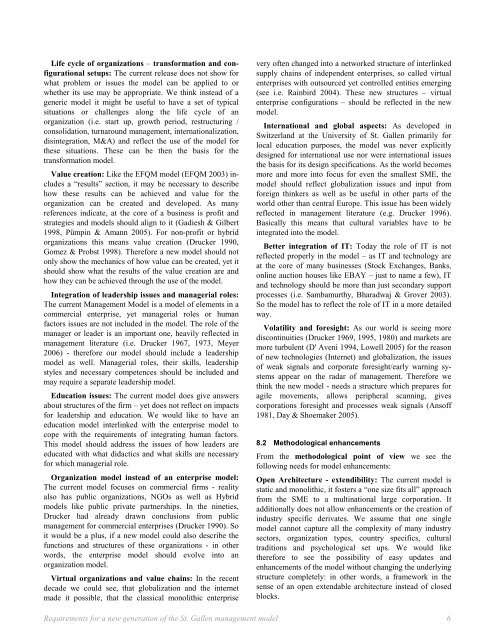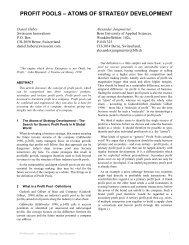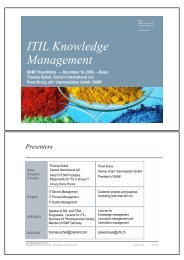requirements for a new generation of the st. gallen management ...
requirements for a new generation of the st. gallen management ...
requirements for a new generation of the st. gallen management ...
Create successful ePaper yourself
Turn your PDF publications into a flip-book with our unique Google optimized e-Paper software.
Life cycle <<strong>st</strong>rong>of</<strong>st</strong>rong> organizations – trans<<strong>st</strong>rong>for</<strong>st</strong>rong>mation and configurational<br />
setups: The current release does not show <<strong>st</strong>rong>for</<strong>st</strong>rong><br />
what problem or issues <<strong>st</strong>rong>the</<strong>st</strong>rong> model can be applied to or<br />
whe<<strong>st</strong>rong>the</<strong>st</strong>rong>r its use may be appropriate. We think in<strong>st</strong>ead <<strong>st</strong>rong>of</<strong>st</strong>rong> a<br />
generic model it might be useful to have a set <<strong>st</strong>rong>of</<strong>st</strong>rong> typical<br />
situations or challenges along <<strong>st</strong>rong>the</<strong>st</strong>rong> life cycle <<strong>st</strong>rong>of</<strong>st</strong>rong> an<br />
organization (i.e. <strong>st</strong>art up, growth period, re<strong>st</strong>ructuring /<br />
consolidation, turnaround <strong>management</strong>, internationalization,<br />
disintegration, M&A) and reflect <<strong>st</strong>rong>the</<strong>st</strong>rong> use <<strong>st</strong>rong>of</<strong>st</strong>rong> <<strong>st</strong>rong>the</<strong>st</strong>rong> model <<strong>st</strong>rong>for</<strong>st</strong>rong><br />
<<strong>st</strong>rong>the</<strong>st</strong>rong>se situations. These can be <<strong>st</strong>rong>the</<strong>st</strong>rong>n <<strong>st</strong>rong>the</<strong>st</strong>rong> basis <<strong>st</strong>rong>for</<strong>st</strong>rong> <<strong>st</strong>rong>the</<strong>st</strong>rong><br />
trans<<strong>st</strong>rong>for</<strong>st</strong>rong>mation model.<br />
Value creation: Like <<strong>st</strong>rong>the</<strong>st</strong>rong> EFQM model (EFQM 2003) includes<br />
a “results” section, it may be necessary to describe<br />
how <<strong>st</strong>rong>the</<strong>st</strong>rong>se results can be achieved and value <<strong>st</strong>rong>for</<strong>st</strong>rong> <<strong>st</strong>rong>the</<strong>st</strong>rong><br />
organization can be created and developed. As many<br />
references indicate, at <<strong>st</strong>rong>the</<strong>st</strong>rong> core <<strong>st</strong>rong>of</<strong>st</strong>rong> a business is pr<<strong>st</strong>rong>of</<strong>st</strong>rong>it and<br />
<strong>st</strong>rategies and models should align to it (Gadiesh & Gilbert<br />
1998, Pümpin & Amann 2005). For non-pr<<strong>st</strong>rong>of</<strong>st</strong>rong>it or hybrid<br />
organizations this means value creation (Drucker 1990,<br />
Gomez & Prob<strong>st</strong> 1998). There<<strong>st</strong>rong>for</<strong>st</strong>rong>e a <<strong>st</strong>rong>new</<strong>st</strong>rong> model should not<br />
only show <<strong>st</strong>rong>the</<strong>st</strong>rong> mechanics <<strong>st</strong>rong>of</<strong>st</strong>rong> how value can be created, yet it<br />
should show what <<strong>st</strong>rong>the</<strong>st</strong>rong> results <<strong>st</strong>rong>of</<strong>st</strong>rong> <<strong>st</strong>rong>the</<strong>st</strong>rong> value creation are and<br />
how <<strong>st</strong>rong>the</<strong>st</strong>rong>y can be achieved through <<strong>st</strong>rong>the</<strong>st</strong>rong> use <<strong>st</strong>rong>of</<strong>st</strong>rong> <<strong>st</strong>rong>the</<strong>st</strong>rong> model.<br />
Integration <<strong>st</strong>rong>of</<strong>st</strong>rong> leadership issues and managerial roles:<br />
The current Management Model is a model <<strong>st</strong>rong>of</<strong>st</strong>rong> elements in a<br />
commercial enterprise, yet managerial roles or human<br />
factors issues are not included in <<strong>st</strong>rong>the</<strong>st</strong>rong> model. The role <<strong>st</strong>rong>of</<strong>st</strong>rong> <<strong>st</strong>rong>the</<strong>st</strong>rong><br />
manager or leader is an important one, heavily reflected in<br />
<strong>management</strong> literature (i.e. Drucker 1967, 1973, Meyer<br />
2006) - <<strong>st</strong>rong>the</<strong>st</strong>rong>re<<strong>st</strong>rong>for</<strong>st</strong>rong>e our model should include a leadership<br />
model as well. Managerial roles, <<strong>st</strong>rong>the</<strong>st</strong>rong>ir skills, leadership<br />
<strong>st</strong>yles and necessary competences should be included and<br />
may require a separate leadership model.<br />
Education issues: The current model does give answers<br />
about <strong>st</strong>ructures <<strong>st</strong>rong>of</<strong>st</strong>rong> <<strong>st</strong>rong>the</<strong>st</strong>rong> firm – yet does not reflect on impacts<br />
<<strong>st</strong>rong>for</<strong>st</strong>rong> leadership and education. We would like to have an<br />
education model interlinked with <<strong>st</strong>rong>the</<strong>st</strong>rong> enterprise model to<br />
cope with <<strong>st</strong>rong>the</<strong>st</strong>rong> <<strong>st</strong>rong>requirements</<strong>st</strong>rong> <<strong>st</strong>rong>of</<strong>st</strong>rong> integrating human factors.<br />
This model should address <<strong>st</strong>rong>the</<strong>st</strong>rong> issues <<strong>st</strong>rong>of</<strong>st</strong>rong> how leaders are<br />
educated with what didactics and what skills are necessary<br />
<<strong>st</strong>rong>for</<strong>st</strong>rong> which managerial role.<br />
Organization model in<strong>st</strong>ead <<strong>st</strong>rong>of</<strong>st</strong>rong> an enterprise model:<br />
The current model focuses on commercial firms - reality<br />
also has public organizations, NGOs as well as Hybrid<br />
models like public private partnerships. In <<strong>st</strong>rong>the</<strong>st</strong>rong> nineties,<br />
Drucker had already drawn conclusions from public<br />
<strong>management</strong> <<strong>st</strong>rong>for</<strong>st</strong>rong> commercial enterprises (Drucker 1990). So<br />
it would be a plus, if a <<strong>st</strong>rong>new</<strong>st</strong>rong> model could also describe <<strong>st</strong>rong>the</<strong>st</strong>rong><br />
functions and <strong>st</strong>ructures <<strong>st</strong>rong>of</<strong>st</strong>rong> <<strong>st</strong>rong>the</<strong>st</strong>rong>se organizations - in o<<strong>st</strong>rong>the</<strong>st</strong>rong>r<br />
words, <<strong>st</strong>rong>the</<strong>st</strong>rong> enterprise model should evolve into an<br />
organization model.<br />
Virtual organizations and value chains: In <<strong>st</strong>rong>the</<strong>st</strong>rong> recent<br />
decade we could see, that globalization and <<strong>st</strong>rong>the</<strong>st</strong>rong> internet<br />
made it possible, that <<strong>st</strong>rong>the</<strong>st</strong>rong> classical monolithic enterprise<br />
very <<strong>st</strong>rong>of</<strong>st</strong>rong>ten changed into a networked <strong>st</strong>ructure <<strong>st</strong>rong>of</<strong>st</strong>rong> interlinked<br />
supply chains <<strong>st</strong>rong>of</<strong>st</strong>rong> independent enterprises, so called virtual<br />
enterprises with outsourced yet controlled entities emerging<br />
(see i.e. Rainbird 2004). These <<strong>st</strong>rong>new</<strong>st</strong>rong> <strong>st</strong>ructures – virtual<br />
enterprise configurations – should be reflected in <<strong>st</strong>rong>the</<strong>st</strong>rong> <<strong>st</strong>rong>new</<strong>st</strong>rong><br />
model.<br />
International and global aspects: As developed in<br />
Switzerland at <<strong>st</strong>rong>the</<strong>st</strong>rong> University <<strong>st</strong>rong>of</<strong>st</strong>rong> St. Gallen primarily <<strong>st</strong>rong>for</<strong>st</strong>rong><br />
local education purposes, <<strong>st</strong>rong>the</<strong>st</strong>rong> model was never explicitly<br />
designed <<strong>st</strong>rong>for</<strong>st</strong>rong> international use nor were international issues<br />
<<strong>st</strong>rong>the</<strong>st</strong>rong> basis <<strong>st</strong>rong>for</<strong>st</strong>rong> its design specifications. As <<strong>st</strong>rong>the</<strong>st</strong>rong> world becomes<br />
more and more into focus <<strong>st</strong>rong>for</<strong>st</strong>rong> even <<strong>st</strong>rong>the</<strong>st</strong>rong> smalle<strong>st</strong> SME, <<strong>st</strong>rong>the</<strong>st</strong>rong><br />
model should reflect globalization issues and input from<br />
<<strong>st</strong>rong>for</<strong>st</strong>rong>eign thinkers as well as be useful in o<<strong>st</strong>rong>the</<strong>st</strong>rong>r parts <<strong>st</strong>rong>of</<strong>st</strong>rong> <<strong>st</strong>rong>the</<strong>st</strong>rong><br />
world o<<strong>st</strong>rong>the</<strong>st</strong>rong>r than central Europe. This issue has been widely<br />
reflected in <strong>management</strong> literature (e.g. Drucker 1996).<br />
Basically this means that cultural variables have to be<br />
integrated into <<strong>st</strong>rong>the</<strong>st</strong>rong> model.<br />
Better integration <<strong>st</strong>rong>of</<strong>st</strong>rong> IT: Today <<strong>st</strong>rong>the</<strong>st</strong>rong> role <<strong>st</strong>rong>of</<strong>st</strong>rong> IT is not<br />
reflected properly in <<strong>st</strong>rong>the</<strong>st</strong>rong> model – as IT and technology are<br />
at <<strong>st</strong>rong>the</<strong>st</strong>rong> core <<strong>st</strong>rong>of</<strong>st</strong>rong> many businesses (Stock Exchanges, Banks,<br />
online auction houses like EBAY – ju<strong>st</strong> to name a few), IT<br />
and technology should be more than ju<strong>st</strong> secondary support<br />
processes (i.e. Sambamurthy, Bharadwaj & Grover 2003).<br />
So <<strong>st</strong>rong>the</<strong>st</strong>rong> model has to reflect <<strong>st</strong>rong>the</<strong>st</strong>rong> role <<strong>st</strong>rong>of</<strong>st</strong>rong> IT in a more detailed<br />
way.<br />
Volatility and <<strong>st</strong>rong>for</<strong>st</strong>rong>esight: As our world is seeing more<br />
discontinuities (Drucker 1969, 1995, 1980) and markets are<br />
more turbulent (D' Aveni 1994, Lowell 2005) <<strong>st</strong>rong>for</<strong>st</strong>rong> <<strong>st</strong>rong>the</<strong>st</strong>rong> reason<br />
<<strong>st</strong>rong>of</<strong>st</strong>rong> <<strong>st</strong>rong>new</<strong>st</strong>rong> technologies (Internet) and globalization, <<strong>st</strong>rong>the</<strong>st</strong>rong> issues<br />
<<strong>st</strong>rong>of</<strong>st</strong>rong> weak signals and corporate <<strong>st</strong>rong>for</<strong>st</strong>rong>esight/early warning sy<strong>st</strong>ems<br />
appear on <<strong>st</strong>rong>the</<strong>st</strong>rong> radar <<strong>st</strong>rong>of</<strong>st</strong>rong> <strong>management</strong>. There<<strong>st</strong>rong>for</<strong>st</strong>rong>e we<br />
think <<strong>st</strong>rong>the</<strong>st</strong>rong> <<strong>st</strong>rong>new</<strong>st</strong>rong> model - needs a <strong>st</strong>ructure which prepares <<strong>st</strong>rong>for</<strong>st</strong>rong><br />
agile movements, allows peripheral scanning, gives<br />
corporations <<strong>st</strong>rong>for</<strong>st</strong>rong>esight and processes weak signals (Ans<<strong>st</strong>rong>of</<strong>st</strong>rong>f<br />
1981, Day & Shoemaker 2005).<br />
8.2 Methodological enhancements<br />
From <<strong>st</strong>rong>the</<strong>st</strong>rong> methodological point <<strong>st</strong>rong>of</<strong>st</strong>rong> view we see <<strong>st</strong>rong>the</<strong>st</strong>rong><br />
following needs <<strong>st</strong>rong>for</<strong>st</strong>rong> model enhancements:<br />
Open Architecture - extendibility: The current model is<br />
<strong>st</strong>atic and monolithic, it fo<strong>st</strong>ers a “one size fits all” approach<br />
from <<strong>st</strong>rong>the</<strong>st</strong>rong> SME to a multinational large corporation. It<br />
additionally does not allow enhancements or <<strong>st</strong>rong>the</<strong>st</strong>rong> creation <<strong>st</strong>rong>of</<strong>st</strong>rong><br />
indu<strong>st</strong>ry specific derivates. We assume that one single<br />
model cannot capture all <<strong>st</strong>rong>the</<strong>st</strong>rong> complexity <<strong>st</strong>rong>of</<strong>st</strong>rong> many indu<strong>st</strong>ry<br />
sectors, organization types, country specifics, cultural<br />
traditions and psychological set ups. We would like<br />
<<strong>st</strong>rong>the</<strong>st</strong>rong>re<<strong>st</strong>rong>for</<strong>st</strong>rong>e to see <<strong>st</strong>rong>the</<strong>st</strong>rong> possibility <<strong>st</strong>rong>of</<strong>st</strong>rong> easy updates and<br />
enhancements <<strong>st</strong>rong>of</<strong>st</strong>rong> <<strong>st</strong>rong>the</<strong>st</strong>rong> model without changing <<strong>st</strong>rong>the</<strong>st</strong>rong> underlying<br />
<strong>st</strong>ructure completely: in o<<strong>st</strong>rong>the</<strong>st</strong>rong>r words, a framework in <<strong>st</strong>rong>the</<strong>st</strong>rong><br />
sense <<strong>st</strong>rong>of</<strong>st</strong>rong> an open extendable architecture in<strong>st</strong>ead <<strong>st</strong>rong>of</<strong>st</strong>rong> closed<br />
blocks.<br />
Requirements <<strong>st</strong>rong>for</<strong>st</strong>rong> a <<strong>st</strong>rong>new</<strong>st</strong>rong> <<strong>st</strong>rong>generation</<strong>st</strong>rong> <<strong>st</strong>rong>of</<strong>st</strong>rong> <<strong>st</strong>rong>the</<strong>st</strong>rong> St. Gallen <strong>management</strong> model 6




